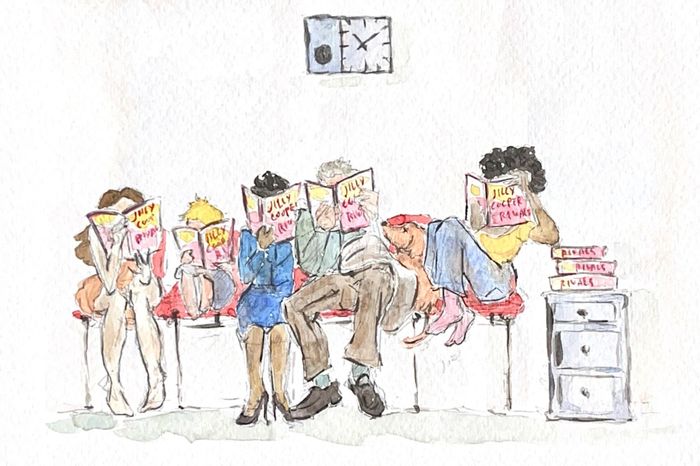Buying books (and identities)
Edie Castell surveys our desire to purchase taste, exploring the rise of ‘BookTok’ and Sally Rooney

Have you read the latest sad girl novel? The latest weird girl novel? Have you got the tote bag to prove it? In the 2020s, books are ‘in’ again, rapidly reclaiming their space in the cultural zeitgeist. At the time of writing, 39.9 million TikToks have been posted under the hashtag ‘BookTok’ - a testament to its influence in the current reading landscape. These posts are often curated around aesthetics, recommending books for ‘it girls’ or ‘thought daughters’, alongside piles of crystals and a pair of Converse. The accompanying audio will be a sound bite from BBC’s Normal People or Gerwig’s Little Women (2019).
When the literature we consume becomes so wound up with other indicators of personal identity, it is no surprise that it is often integral to the way we perceive, and therefore present, ourselves. Take Sally Rooney as an example. Off the bat of yet another commercial success with Intermezzo - which The Bookseller reported to be Faber’s “biggest trade campaign ever” - the wider Rooney brand is newly unmistakable.
“The pre-existence of a brand may lead to reductive interpretations of a piece of art”
One can envision an archetypal Rooney reader with ease: they are young, left-leaning, and order oat milk in their coffee. Were they a Cambridge student, they would frequent Sidgwick site, finding themselves right at home amongst the skinny scarves and brown leather jackets. A quick search on social media would indeed support these assumptions, with many publishers and authors readily playing into these stereotypes in their marketing. As such, a specific brand is built up around authors, which has real implications on how their work is consumed.
Firstly, the pre-existence of a brand may lead to reductive interpretations of a piece of art. The novel is forced to exist within a paradigm, constantly butting its head against the assumptions pre-afforded to it. Such is true of Rooney’s work: hailed as the mother of ‘sad girl lit’, readers are quick to prescribe her romances as tragedies. The author herself has other ideas, pushing back against the label in an interview with The Guardian this September. On the contrary, she sees her novels as “optimistic”.
It is of course true to say that relationships crafted by Rooney are riddled with miscommunication and questionable sexual dynamics. To feel sad for Marianne and Connell, or Peter and Sylvia, is by no means an invalid response, nor one without use. But to go into a book in anticipation of a particular mood limits our ability to grasp all of its offerings. Would it be so outrageous, I wonder, to view Marianne and Connell’s final conversation in Normal People as an opening rather than a bitter end?
“to claim the identity of ‘reader’, it is no longer enough to just… read”
Perhaps more worryingly, the coalescence of books and other products is driving us to consume more. Paradoxically, it seems as if to claim the identity of ‘reader’, it is no longer enough to just… read. On social media, the novel is inseparable from its physical form, with particular attention afforded to the book’s aesthetic value alongside its intellectual one. The more beautiful covers of a novel are inevitably favoured, and the pursuit of these often leads to the purchasing of multiple editions. Furthermore, the desire to fully embody the identity of ‘reader’ leads to an array of secondary purchases; merchandise, prints, a certain style of dress. The bookish tote bag, now a staple of marketing campaigns, loses its allure of sustainability once we accumulate five or six, or even ten of them.
This is not a new phenomenon. Under capitalism, the novel is inevitably a product before it is a piece of art. As early as the eighteenth century, Alexander Pope condemned the rapid consumption of art as a status symbol in his ‘Epistle to Burlington’. Just as Pope laments the purchase of “rare monkish manuscripts for Hearne alone”, we can likewise track the desire to impress in our own shopping habits. Nevertheless, it is not absurd to attribute the sheer volume of our consumption to the rise of social media. Platforms like TikTok pioneer new ‘identities’ at a rate quicker than ever before, meaning that there are designated ‘must need’ products for every ‘type’ of reader.
Cambridge students certainly aren’t immune to this practice, and why would we be? There is something very human about the desire to belong, and conforming to a particular identity certainly helps to achieve this. The development of niche subgroups like the ‘thought daughter’ isn’t confined to the chronically online - the same can be found on our own campus (Sidge Girlies, anyone?). Of course, curating a lifestyle around our favourite books can prove to be a particularly fulfilling experience, and can even make reading more appealing to the masses - we should just be more mindful about where this cultivation is taking us, and whether consumption is taking precedence over genuine enjoyment.
 Comment / Cambridge students are too opinionated 21 April 2025
Comment / Cambridge students are too opinionated 21 April 2025 News / Candidates clash over Chancellorship25 April 2025
News / Candidates clash over Chancellorship25 April 2025 News / Cambridge professor paid over $1 million for FBI intel since 199125 April 2025
News / Cambridge professor paid over $1 million for FBI intel since 199125 April 2025 News / Zero students expelled for sexual misconduct in 2024 25 April 2025
News / Zero students expelled for sexual misconduct in 2024 25 April 2025 Comment / Does the AI revolution render coursework obsolete?23 April 2025
Comment / Does the AI revolution render coursework obsolete?23 April 2025






